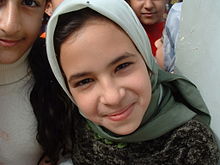
Back Hidjab Afrikaans حجاب (إسلام) Arabic হিজাব Assamese Hicab Azerbaijani Хижаб Bashkir Hijab BCL Хіджаб Byelorussian Хіджаб BE-X-OLD Хиджаб Bulgarian हिजाब Bihari

The word hijab is used in the Qur'an to denote a partition, or a curtain,[1][2] but in modern usage often refers to a woman's headscarf. This is often done amongst Muslims for females over the age of puberty.[3][4] For most Muslims, the headscarf, a symbol of hijab, is worn in the presence of adult males outside their immediate family; it is not necessary when females or males are within their immediate family. However, some Muslim scholars and activists maintain that the practice of covering the hair with a hijab is not mandated in Islam.[5][6][7][8]
The word ḥijāb, or a derivative, appears eight times in the Qur'an and never connotes any act of piety or headscarf.[9] It appears as an "obstacle" (7:46), a "curtain" (33:53), "hidden" (38:32), a "wall of separation" (41:5, 42:52, 17:45), "hiding" (19:14) and "prevented" or "denied access to God" (83:15).[10]
The "hijab" as a headscarf can come in several different types, such as an ordinary veil (which only covers the head), a niqab, a burka also known as an abayah, which covers the entire body, and any form of covering used to veil.[11] There are many styles to wear. The Quran however has no requirement that women cover their faces with a veil, or cover their bodies with the full-body burqa or chador.[12]
The "hijab" as a headscarf is currently required by law to be worn by women in Iran and Afghanistan.[13] It is no longer required by law in Saudi Arabia since 2018.[14][15][16][17][18][19] In Gaza, Palestinian jihadists belonging to the Unified Leadership (UNLU) have rejected a hijab policy for women.[20] They have also targeted those who seek to impose the hijab.[20] Other countries, both in Europe and in the Muslim world, have passed laws banning some or all types of hijab in public or in certain types of locales.
- ↑ Mark Juergensmeyer, Wade Clark Roof, ed. (2012). "Hijab". Encyclopedia of Global Religion. Vol. 1. SAGE Publications. p. 516. doi:10.4135/9781412997898. ISBN 9780761927297.
- ↑ El Guindi, Fadwa; Sherifa Zahur (2009). Hijab. The Oxford Encyclopedia of the Islamic World. doi:10.1093/acref/9780195305135.001.0001. ISBN 9780195305135.
- ↑ Murphy R.F. 1964. Social distance and the veil. American Anthropologist. New Series, 66, No. 6, Part 1, pp. 1257–1274.
- ↑ Brenner S. 1996. Reconstructing self and society: Javanese Muslim women and "the veil". American Ethnologist, 23, (4) , pp. 673–697.
- ↑ "unicornsorg". Archived from the original on 21 December 2015. Retrieved 26 December 2015.
- ↑ "Moroccoworldnews.com". Archived from the original on 27 December 2015. Retrieved 26 December 2015.
- ↑ Nomani, Asra Q.; Arafa, Hala (21 December 2015). "Opinion: As Muslim women, we actually ask you not to wear the hijab in the name of interfaith solidarity". Washington Post. Retrieved 22 December 2022.
- ↑ "No Ritu Kumar, all Muslim women don't wear hijab - the New Indian Express".
- ↑ https://www.washingtonpost.com/news/acts-of-faith/wp/2015/12/21/as-muslim-women-we-actually-ask-you-not-to-wear-the-hijab-in-the-name-of-interfaith-solidarity/
- ↑ https://www.washingtonpost.com/news/acts-of-faith/wp/2015/12/21/as-muslim-women-we-actually-ask-you-not-to-wear-the-hijab-in-the-name-of-interfaith-solidarity/
- ↑ Wear, Muslima. "Muslima Hijabs". Muslima Wear. Retrieved 2021-12-02.
- ↑ Tristam, Pierre. Does the Quran require women to wear the veil? About News. [1] Archived 2014-10-11 at the Wayback Machine
- ↑ "'Why didn't you wear a hijab?' Taliban militants shoot 21-year-old Afghan girl". News Track. 5 August 2021. Retrieved 15 August 2021.
- ↑ Schams Elwazer (28 May 2014). "Skimpy clothing targeted in Gulf cover-up campaigns". CNN. Retrieved 2022-08-02.
- ↑ "9 Misconceptions about traveling to Saudi Arabia as a woman - Against the Compass". 2021-01-09. Retrieved 6 February 2021.
I did not cover my hair because, one, it's not the law, and two, I didn't have a scarf anyway.
- ↑ Abdulaziz, Donna (2 October 2019). "Saudi Women Are Breaking Free From the Black Abaya". The Wall Street Journal. ISSN 0099-9660. Retrieved 6 February 2021.
Almost immediately, women became more comfortable wearing their headscarves loosely or not at all
- ↑ "Women in Saudi Arabia do not need to wear head cover, says crown prince". The Irish Times. Retrieved 6 February 2021.
This, however, does not particularly specify a black abaya or a black head cover. The decision is entirely left for women to decide what type of decent and respectful attire she chooses to wear.
- ↑ Nic Robertson (December 5, 2020). "Saudi Arabia has changed beyond recognition. But will tourists want to visit?". CNN.
- ↑ Mail, Daily (15 September 2019). "Rebel Saudi women appear in public without hijab, abaya; onlookers stunned | New Straits Times". NST Online. Retrieved 13 January 2021.
- ↑ 20.0 20.1 "Women, the Hijab and the Intifada". 4 May 1990.